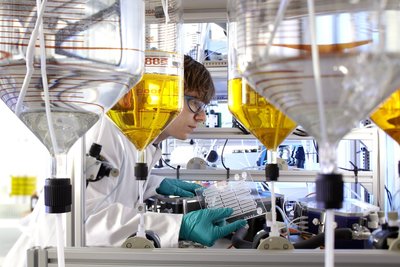Small ways to produce big bangs
Microreactors can be used to produce explosive materials such as nitroglycerine, about 10 times more quickly than they can be synthesised in conventional vessels. And the process is safer too.
Producing explosives calls for extreme caution. If you want to tunnel through a mountain you can blast through the rock with explosive gelatin made largely out of nitroglycerine - better known as dynamite. But no one wants a demonstration of these explosive forces in their lab.
Because the production process of explosive materials generates heat, it must proceed slowly: drop for drop, the reagents are added to the agitating vessel that holds the initial substance. An explosion can result if the mixture heats up too quickly. The heat generated cannot be permitted to exceed the heat dissipated.
Researchers at the Fraunhofer Institute for Chemical Technology ICT in Pfinztal have developed a method for safer production of nitroglycerine: a microreactor process that has been tailored to this specific reaction.

What makes the process safer are the tiny quantities involved. Smaller quantities means less heat is generated and because the surface is very expansive compared to the volume involved, the system is very easy to cool. Another benefit: the tiny reactor produces the explosive material considerably faster than in agitating vessels. Unlike a large agitating vessel filled before the slow reaction proceeds, the microreactor works continuously: the base materials flow through tiny channels into the reaction chamber in ‘assembly-line fashion’.
There, they react with one another for several seconds before flowing through other channels into a second microreactor for purification. (The interim product from the first microreactor contains impurities that need to be removed for safety reasons.)
Purification in the microreactor functions perfectly: the product produced meets pharmaceutical specifications and in a modified form can even be used in nitro capsules for patients with heart disease.
“This marks the first use of microreactors in a process not only for synthesis of a material but also for its subsequent processing,” claims Dr Stefan Löbbecke, Deputy Division Director at ICT.
Customising microreactors
When developing a microreactor, researchers need to match the reactors to the reaction desired:
- How large should the channels be to ensure that the heat generated can be dissipated effectively?
- Where do impediments need to be built into the channels to ensure that the fluids are well blended and the reaction proceeds as planned?
Another important parameter is the speed with which the liquids flow through the channels: on the one hand, they need enough time to react with one another, while on the other the reaction should come to an end as soon as the product is formed. Otherwise, the result might be too many unwanted by-products.
While microreactors suggest themselves for explosive materials, this is not the only conceivable application: researchers at ICT build reactors for every chemical reaction conceivable - and each is tailored to the particular reaction involved.
Just one of numerous other examples is a microreactor that produces polymers for OLEDs. OLEDs are organic light-emitting diodes that are particularly common in displays and monitors. The polymers of which the OLEDs are made light up in colours. However, as they are synthesised imperfections easily arise that rob the polymers of some of their luminosity.
“Through precise process management, we are able to minimise the number of these imperfections,“ Löbbecke points out. To accomplish this, researchers first analysed the reaction in minute detail: When do the polymers form? When do the imperfections arise? How fast does the process need to be?
“As it turns out, many of the reaction protocol that people are familiar with from batch processes are unnecessary. Often, the base materials don‘t need to boil for hours at a time; in many cases all it takes is a few seconds,” the researcher has found. Long periods spent boiling can cause the products to decompose or generate unwanted by-products.
To develop and perfect a microreactor for a new reaction, the researchers study the ongoing reaction in real time - peering into the reactor itself, so to speak. Various analytical procedures are helpful in this regard: some, such as spectroscopic techniques, reveal which kinds of products are created in the reactor - and thus how researchers can systematically increase yields of the desired product, possibly even preventing by-products from forming in the first place.
Other analytical methods, such as calorimetry, provide scientists with information about the heat released over the course of a reaction. This measurement method tells them how quickly and completely the reaction is proceeding. It also provides an indication of how the process conditions need to be selected to ensure that the reaction proceeds safely.
www.fraunhofer.de
Light pollution promotes blue-green algae growth in lakes
Artificial light at night promotes the proliferation of cyanobacteria, also known as blue-green...
Solar-powered reactor uses CO2 to make sustainable fuel
Researchers have developed a reactor that pulls carbon dioxide directly from the air and converts...
Scientists simulate the effects of an asteroid collision
How would our planet physically react to a future asteroid strike? Researchers simulated an...




